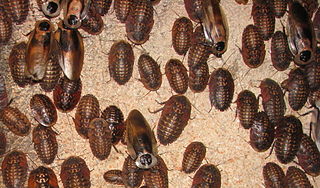
Giant cockroaches, or blaberids, are the second-largest cockroach family by number of species. Mostly distributed in warmer climates worldwide, this family is based on the American genus Blaberus, but much of the diversity is also found in Africa and Asia.
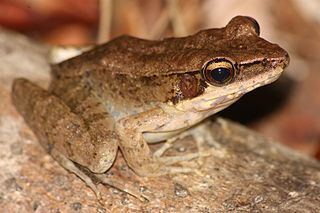
Papurana daemeli is a species of "true frog", family Ranidae. It is found in New Guinea, northern Australia, and some smaller islands. It is the only ranid frog found in Australia. In Australia, the species is restricted to the rainforest of northern Queensland and the eastern border of Arnhem Land, in the Northern Territory. In Australia, it is usually known as wood frog or sometimes as water frog. Other vernacular names are Australian wood frog, Australian bullfrog, and Arnhem rana.

Cockroaches are insects belonging to the order Blattodea (Blattaria). About 30 cockroach species out of 4,600 are associated with human habitats. Some species are well-known as pests.

The king brown snake is a species of highly venomous snake of the family Elapidae, native to northern, western, and Central Australia. Despite its common name, it is a member of the genus Pseudechis and only distantly related to true brown snakes. Its alternative common name is the mulga snake, although it lives in many habitats apart from mulga. First described by English zoologist John Edward Gray in 1842, it is a robust snake up to 3.3 m (11 ft) long. It is variable in appearance, with individuals from northern Australia having tan upper parts, while those from southern Australia are dark brown to blackish. Sometimes, it is seen in a reddish-green texture. The dorsal scales are two-toned, sometimes giving the snake a patterned appearance. Its underside is cream or white, often with orange splotches. The species is oviparous. The snake is considered to be a least-concern species according to the International Union for Conservation of Nature, though may have declined with the spread of the cane toad.

The western swamp turtle or western swamp tortoise is a critically endangered species of freshwater turtle endemic to a small portion of Western Australia. It is the only member of the genus Pseudemydura in the monotypic subfamily Pseudemydurinae.

The white-striped free-tailed bat is a species of bat in the family Molossidae. Its echolocation calls are audible to humans, which is a characteristic found in only a few microbat species. The species was formerly classified as Tadarida australis.
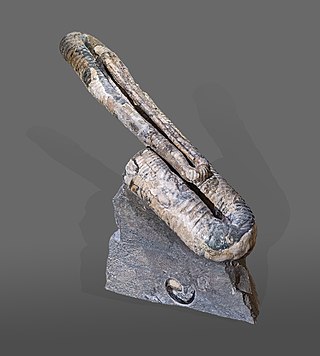
Polyptychoceras is an extinct genus of ammonites from the Late Cretaceous of Asia, Europe, and North and South America. It was first named by Hisakatsu Yabe in 1927.

Liotina is a genus of sea snails, marine gastropod mollusks in the family Liotiidae.
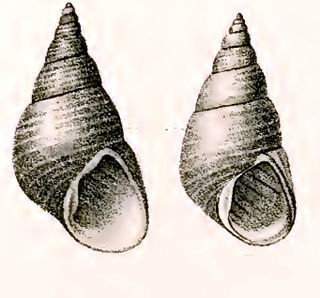
Phasianotrochus eximius, common name the kelp shell or true kelp, is a species of sea snail, a marine gastropod mollusk in the family Trochidae, the top snails.
Calthalotia fragum is the common name of the spotted strawberry top shell or the comtesse's top shell, is a species of sea snail, a marine gastropod mollusk in the family Trochidae, the top snails.

Panesthia cribrata, commonly called the Australian wood cockroach, is a wood-eating species found in rotten logs. It is found from south east Queensland south to the east coast to Tasmania, also seen at Norfolk Island. It depends on wood for sustenance, and manufactures enzymes that digest cellulose.

Grevillea brachystylis, also known as short-styled grevillea, is a species of flowering plant in the family Proteaceae and is endemic to the south-west of Western Australia. It is a low, spreading to erect shrub with linear to narrow egg-shaped leaves with the narrow end towards the base, and wheel-like clusters of hairy red flowers.
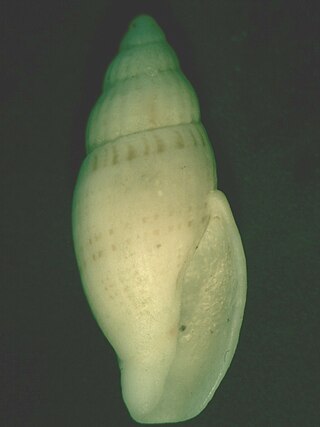
Guraleus australis is a species of sea snail, a marine gastropod mollusk in the family Mangeliidae.

Turriplicifer australis is a species of sea snail, a marine gastropod mollusk, in the family Costellariidae, the ribbed miters.

The banded grouper, also known as the blunt-headed rock cod, the bighead grouper, white-spotted green grouper, and yellow-lipped rock-cod, is a species of marine ray-finned fish, a grouper from the subfamily Epinephelinae which is part of the family Serranidae, which also includes the anthias and sea basses. It comes from the western Pacific Ocean.
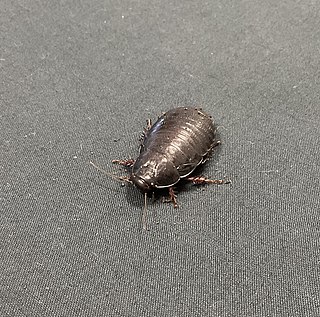
Panesthia lata, the Lord Howe Island wood-feeding cockroach or Lord Howe Island cockroach, is a large, wingless cockroach species endemic to the Lord Howe Island Group in the Tasman Sea.

Panesthiinae is a subfamily of giant cockroaches (Blaberidae) mostly found in Indo-Malaysia and Australia.
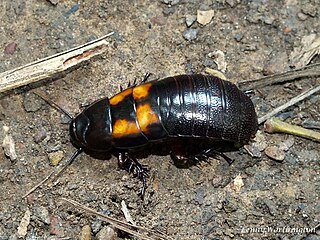
Panesthia is a large genus of burrowing giant cockroach in the subfamily Panesthiinae. It is subsocial and its species are mainly found in Southeast Asia, coastal East Asia, Australasia, and Indo-Malaysia.
Eucorydia donanensis is a species of iridescent cockroach in the family Corydiidae. It was discovered on Yonaguni Island of Japan's Ryukyu Archipelago, and was believed to be restricted to that island until its discovery on nearby Ishigakijima Island in June 2022.
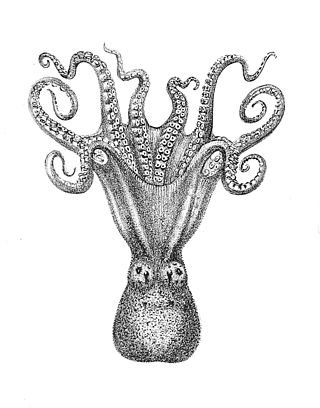
Octopus australis is a species of octopus. It gets the common name hammer octopus from a modified arm possessed by males and used in reproduction. It was first described by William Evans Hoyle in 1885, based on a specimen found in Port Jackson in New South Wales.


















